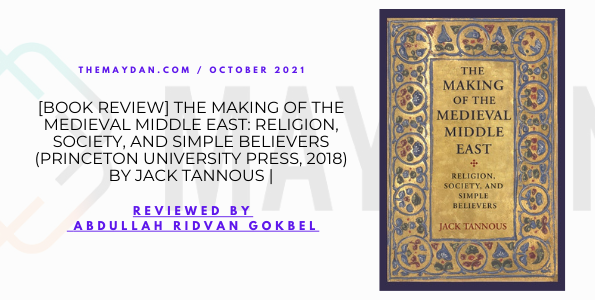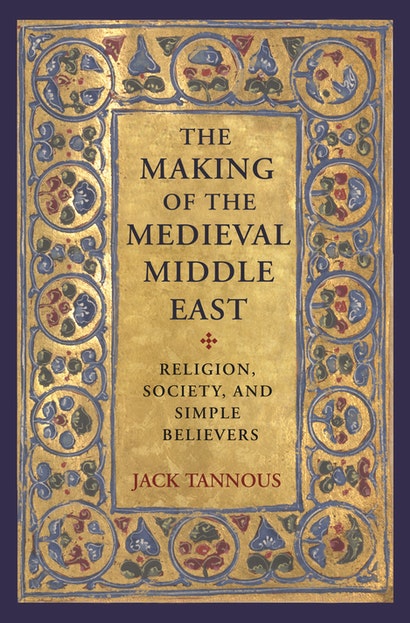
Jack Tannous, The Making of the Medieval Middle East: Religion, Society, and Simple Believers (Princeton: Princeton University Press, 2018). 647 pages. $39.95.
The history of relations between Christians and Muslims in the Middle East -particularly in Bilād al-Shām– is older than that in almost any other part of the Islamic World.[1] So it should come as no surprise that these encounters have given both the early Islamic period and the Middle Eastern region pride of place in the comparative studies of these religions. In the last several decades, it has become increasingly common for scholars to attempt to think together the late antique and early Islamic worlds.
“In the last several decades, it has become increasingly common for scholars to attempt to think together the late antique and early Islamic worlds.”Jack Tannous’ The Making of the Medieval Middle East: Religion, Society, and Simple Believers is thus a fresh contribution to the already-populated set of works attempting to discover the origins of Islam in the late antiquity authored by scholars such as Aziz Al-Azmeh, Robert G. Hoyland, Antoine Borrut and Gabriel Said Reynolds.[2]
Content Overview
Tannous’ work is based on two essential questions: first, what would it mean in the late Roman and medieval worlds for people with little-to-no education to belong to a church whose identity was articulated in part through councils, and how would their understanding differ from that of the educated religious elite of their time? Second, how did the Middle East go from being the birthplace of Christianity and eventually a largely Christian region, to a land where Christianity was only a minority religion? It should be noted that, as the author points out in the introduction to the book, his Palestinian origin lead him to delve into these questions too. Tannous notes that the second question cannot be properly addressed without considering the first, and thus attempts to answer the first question by looking at the lives of ordinary people of that period, as opposed to its scholars. For that reason, he asks the following question to form the basis of his research; What if the churchmen and Muslim religious authorities were the exception, not the rule? In doing so, Tannous expresses an appreciation for the work of previous researchers while also successfully bringing a different perspective. He emphasizes that to understand how Arab conquerors connected with the traditions of the populations they conquered and, more specifically, how Christians and Muslims interacted, we must first cultivate a deep understanding of Christian-Christian interactions.
“He emphasizes that to understand how Arab conquerors connected with the traditions of the populations they conquered and, more specifically, how Christians and Muslims interacted, we must first cultivate a deep understanding of Christian-Christian interactions.”
Each of the four parts of the book examine, in chronological order, the phases of Christian society at that time. The first part focuses on the ordinary people who constitute the vast majority of Christians in the Middle East, and were what church leaders of the time called “simple.” These people were overwhelmingly agrarian, mostly illiterate, and likely had little understanding of the theological complexities that split apart the Christian community in the region. As the author explains in the first chapter, ‘simple’ here does not mean ‘simple-minded,’ as it might in some varieties of English, nor should it be understood as a category restricted to the laity: there were monks, priests, and even bishops who were simple believers. For Tannous, a key element to understand the world that the Arabs found, is to understand it as one of simple, ordinary Christians, most of whom did not fully understand the doctrinal disagreements that divided their world into various rival sects.
The second part of the book deals with how this event can help explain the shape that Middle Eastern Christianity took in the centuries after the Council of Chalcedon and before the Arab conquests. The competition between the leaders of various Christian movements during the early Islamic period gave rise to various debates and a culture of f polemics, the translation of texts, the creation of educational institutions, and the development of a Syriac-language syllabus of study in the seventh century. Tannous also discusses the rivalry between Catholic and Protestant missionaries in the nineteenth century Middle East and its educational consequences for the region, particularly for Lebanon, based on theological encounters between Christians.
Tannous separates between the second and third chapters of the book with an “Interlude: The Question of Continuity.” This interlude deals with the question of continuity/discontinuity between the periods of Roman and Arab rule in the Middle East. According to Tannous, the competition among religious elites led to a series of remarkable intellectual continuities in the Syriac-speaking world across the sixth to ninth centuries, a time that has traditionally been seen as one of great cultural rupture.
The third part of the book explains the religious landscape outlined in the first two chapters. In this context, Tannous states that he focuses on Christians, the society he is most familiar with among Middle Eastern societies, as the other groups such as Jews and Zoroastrians should be examined by separate academic studies. The author also notes that there is a rich body of scholarship that has located, classified, and analyzed instances of Christian-Muslim encounter, for that reason he does not look at how Christians and Muslims relate to each other, but rather he focuses on what “Christian” and “Muslim” meant in the seventh and eighth centuries. Additionally, Tannous -in the chapter that focuses on the motivations, meaning, and consequences of conversion- makes a reference to Sydney Griffith’s seminal work on Christian groups living under Muslim rule, The Church in the Shadow of the Mosque [3], as he calls this chapter “The Mosque in the Shadow of the Church”.
Medieval Middle Eastern history is the focus of the final chapter. In this section, Tannous emphasizes that the field of medieval Middle Eastern history is commonly understood to be Islamic history. Just as the book Christians and Others in the Umayyad State (Chicago, 2016)[4] edited by Antoine Borrut and Fred Donner, points out, Tannous suggests that non-Muslims in early Islam & late antiquity were neglected in academic studies. Therefore, Tannous emphasizes that this period is not just about Islamic history. Furthermore, Tannous propounds that social history provides a key approach for finding out the role that non-Muslims played in making the world that scholars of the region in this period study.
Contributions and Critique
Tannous’ effort to explain the medieval Middle East through the lenses of simple and ordinary believers rather than scholars and great figures is a one-of-a-kind contribution. Focusing on the period between 500-1000 CE, Tannous paints a picture of a vast area from the Chalcedonian Council to the pre-Crusader Abbasid state based on primary sources in ancient languages ranging from Arabic to Syriac to Greek.
“He emphasizes that to understand how Arab conquerors connected with the traditions of the populations they conquered and, more specifically, how Christians and Muslims interacted, we must first cultivate a deep understanding of Christian-Christian interactions.”
However, given that the Chalcedonian Council occupies a crucial place for the general arguments of the book, the lack of key information on the Chalcedonian council is sorely felt, as non-experts may have difficulty understanding the context. Furthermore, the use of the expression “the Middle East” in the title is slightly misleading, as it is based on a very recently developed colonial geographic definition and may lead to some misunderstanding. Today the Middle East generally brings to mind the contemporary modern nation states within the Arabian Peninsula, the Levant and Iran. However, as the author states, the focus of the book is on Syria, Palestine, and Iraq.
In addition, Tannous also has controversial claims about early Islamic history. For example, Tannous notes that most of the Prophet’s fictional followers, including many of the leaders of the early Muslim state, were people who had converted late in his life for apparently secular reasons. From Tannous’ point of view, conversion from Christianity to Islam may not have been that significant from a religious point of view, given the social and economic benefits from the perspective of ordinary believers. However, more emphasis should be placed on the fact that this view is found in the Syriac Christian chronicles, but there are other views in the chronicles of the classical Muslim historians and more convincing arguments should be presented to support the author’s claims. Otherwise, these claims give the general reader the impression of an ideological reading against early Islamic history.
These minor criticisms aside, it is clear that the book is a significant contribution to a field which needs further study to explain historical developments among the non-Muslim communities in the early Islamic period.
Abdullah Ridvan Gokbel is a PhD candidate in the Department of History of Religions at Istanbul University Faculty of Theology and a researcher and alumni of ISAR Foundation, that presents special education on Islamic and social sciences. He holds a BA degree in Islamic Theology from Istanbul 29 Mayis University and a MA in the Department of History of Religions at Istanbul University Faculty of Theology. His first book, The Qurʾān and Christians: the Qurʾān in the Works of Arab-Syriac Christians in the First Three Islamic Centuries (Ankara: Eski Yeni, 2020) was published in Turkish in 2020. His research focuses on Muslim-Christian polemics of the Middle Ages and Ottoman intellectual history.
*The author first presented this review at the Fourth Annual Graduate Students Book Review Colloquium on Islam and Middle Eastern Studies in 2020 organized by Ali Vural Ak Center for Global Islamic Studies at George Mason University and the Maydan in collaboration with the Fall for the Book Festival.
[1] David Thomas (ed.), Syrian Christians Under Islam: The First Thousand Years, (Leiden: Brill, 2001), p. 1.
[2] The literature has been and is growing vast and rich. See, e.g., A. al-Azmeh, The Emergence of Islam in Late Antiquity: Allāh and His People (New York, 2014) and R. G. Hoyland, ed., The Late Antique World of Early Islam: Muslims among Christians and Jews in the East Mediterranean (Princeton, 2015), the latter one volume of more than two dozen that have been published in the landmark series, edited by Lawrence Conrad and Jens Scheiner, Studies in Late Antiquity and Early Islam. G. Fowden, Before and after Muḥammad: The First Millennium (Princeton, 2014), represented an ambitious attempt at reperiodization. A. Borrut and Fred Donner, eds., Christians and Others in the Umayyad State (Chicago, 2016), can be taken as representative of an increasingly prominent tendency among scholars to focus on non-Muslims in medieval Muslim empires. G. S. Reynolds, ed., The Qur’ān in Its Historical Context (London/New York, 2008); Reynolds, ed., New Perspectives on the Qur’ān: The Qur’ān in Its Historical Context 2; and N. Schmidt, N. K. Schmidt, and A. Neuwirth, eds., Denkraum Spätantike: Reflexionen von Antiken im Umfeld des Koran (Wiesbaden, 2016).
[3] For more information on the title of the book, see Sidney H. Griffith, The Church in the Shadow of the Mosque: Christians and Muslims in the World of Islam, (New Jersey: Princeton University Press, 2007), p. 4.
[4] Antoine Borrut and Fred Donner, Christians and Others in the Umayyad State, (Chicago: The Oriental Institute, 2016), p. 6.


